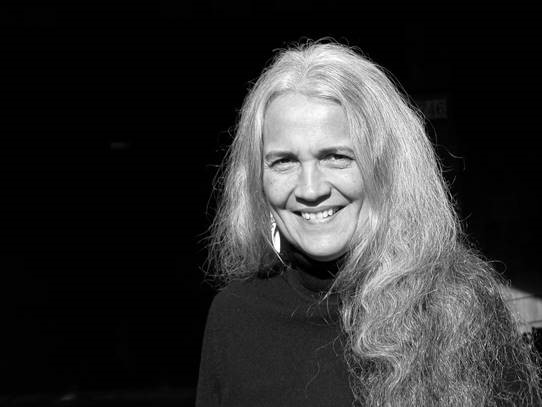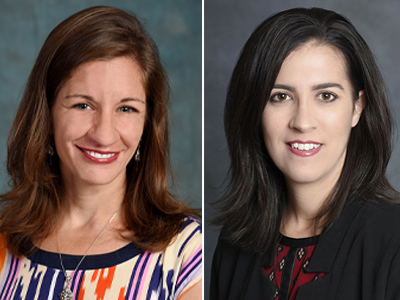UIC Nursing faculty to tackle trauma in Indigenous community
Story begins Heading link

Hillman Foundation grant helps fund nurse-driven program
Two faculty members from the UIC College of Nursing received a grant to bring an innovative therapy program to members of a northern California tribe as a way to address trauma and reduce health disparities among the Yurok people.
Assistant professor Kylea Liese, PhD, CNM, and professor Crystal Patil, PhD, are co-investigators on the grant from the Hillman Foundation to pilot the nurse-driven program, YurokNet Wellness, using Narrative Exposure Therapy, a tool that has been found to successfully address trauma in other populations.
Although Liese’s most recent work has been more locally focused – on health disparities among pregnant Black people in Chicago – when she heard about Narrative Exposure Therapy, she recognized an opportunity to address health issues in another community, one in which she has familial ties.
Liese’s aunt is the chief judge of the Yurok Tribe, which is the largest surviving federally recognized tribe in California. Abby Abinanti, known as Judge Abby, has been featured in Hillary and Chelsea Clinton’s Apple TV series, “Gutsy,” for her efforts to improve wellness through the Yurok Wellness Court, an innovative justice system that uses traditional justice strategies.
“Through Abby, I have a relationship with a very special community that has been historically marginalized, traumatize and terrorized, leading to unforgivable disparities,” Liese says. “My aunt works tirelessly to get her people the tools and services that they need to address the trauma and be well. This project is one way that, as a researcher, I can help.”
Liese adds: “We wrote the grant together to adapt an evidence-based trauma intervention for their community’s context and to demonstrate whether the intervention is feasible, acceptable and effective. We plan to continue to use our resources to support their drive to improve wellness.”
Borne of 175-year-old trauma Heading link

Colonial invasion, massacres, indentured servitude — primarily involving children — and forcing children to attend abusive boarding schools have created trickle-down problems that continue to plague the people of the Yurok Tribe.
“That trauma has resulted in behavior that’s not acceptable to us in our culture,” Judge Abby says. “We’re dealing with many aspects of poverty-burdened communities including fentanyl abuse, domestic violence, and murdered and missing women. We really need to try to figure out a way to make people not engage in negative behavior, protect our women and children and return to our cultural value system.”
Liese calls the health disparities “mind-boggling.” In Klamath, which is located on the Yurok Indian Reservation, 30% of residents live in poverty, according to 2019 census estimates, the highest rate in the county. The rate of drug poisoning deaths, or overdoses, among American Indian and Alaskan Natives in Humboldt County, which houses part of the reservation, is about twice that of white (non-Hispanic) people. Child abuse and neglect allegations are at “crisis levels,” according to a U.S. Department of Education 2021 report, and the Tribe declared a state of emergency in 2016 due to a rash of suicides by young people (rates in Humboldt County were three times higher than the state average).
“There’s huge disparity between the Yurok and surrounding communities, in terms of opiate use, death by opiates, having children taken away, domestic violence, suicide, other mental health conditions, and stress-related health conditions like heart disease,” Liese says.
YurokNet Wellness will be delivered to clients of the Yurok Wellness Court, which serves individuals involved with the child welfare and criminal justice systems, as well as veterans. Each client in Wellness Court is assigned a Yurok advocate, who are trained to act as traditional supportive “aunts” and “uncles” in the community and will deliver the therapy.
“What we’re hoping is this will be a way to train people in the community to assist each other to respond in a way that is not self-destructive,” Judge Abby says. “It’s a huge need, and we’re trying to fill a gap. We’re trying to fill it in a way that works in a culture that has traditionally been very responsibility-based, where community members feel a sense of interlocking responsibilities.”
What is Narrative Exposure Therapy?
Narrative Exposure Therapy was initially designed as a way for non-professionals to help refugees process trauma. Through a series of sessions, advocates help participants create a symbolic lifeline, identifying events in life that brought them joy or harm, as well as instances where they perpetrated harm. The advocate then creates a narrative, helping the participant to explore their traumas by asking follow-up questions.
Liese says it’s particularly important for participants to recount what their body felt like during the trauma as compared to how it feels in the current moment.
“With PTSD, when your memories are triggered, your brain thinks, ‘I’m in the war zone right now,’” Liese says. “The idea is that if you can help your brain distinguish right now from your past, that allows you to process the trauma as passed. It’s less triggering in the present.”
The grant will allow Liese and Patil to adapt the therapy to the Yurok people, bring in an international expert on Narrative Exposure Therapy to train community advocates, and to test the program.
“We will draw on our qualitative, community engaged expertise as researchers to work closely with the Yurok to collaboratively adapt of this intervention so that it best meets community needs and expectations,” says Patil.
The goal is to gather data on its feasibility and expand the program, eventually bringing it to other tribes.
“It’s made for our type of communities,” Judge Abby says. “At this point there are 560-plus tribes in the country, many of them isolated. We really need to model these types of programs.”
Liese adds that trauma can get passed down from generation to generation. Indigenous people have higher rates of children being removed from custody than any other community, which Liese traces back to a 150-year-long history of the federal government removing Native children from their families to attend boarding schools, where they were forced to relinquish their own culture and assimilate into the European American mainstream.
“You have a community that have generations of massacres and trauma that continue to live out in modern-day perspective — and on top of that, you have a lot of serious health and wellness conditions that continue to transmit down the generations,” Liese says. “They’re already at higher risk for developing heart disease, for suicide and other mental health conditions. The idea is if you can disrupt some of that cycle, and address some of that trauma, it can allow people in communities to become aware of the link between their behaviors and health and begin to heal.”